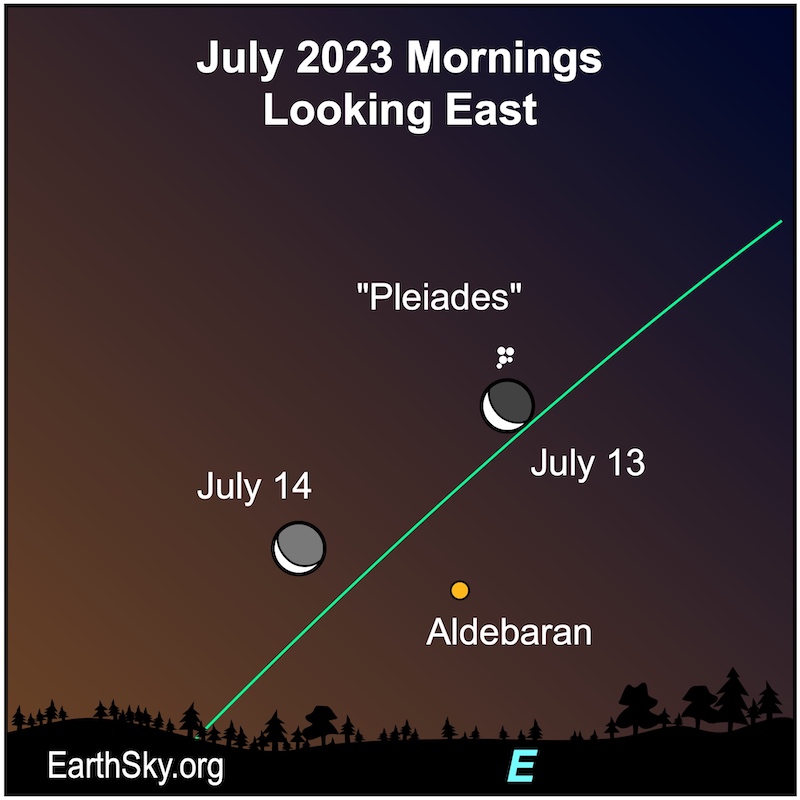Early risers can enjoy a lovely view of a waning crescent moon near the delicate and beautiful open star cluster known as the Pleiades. Also, look for the glow of earthshine on the darkened portion of the moon.

Moon near the Pleiades and Aldebaran
For everyone around the globe, the waning crescent moon will be near the glittering Pleiades star cluster on the mornings of July 13 and 14, 2023. The Pleiades, shaped like a tiny dipper, are also called the Seven Sisters or Messier 45 (M45). They’re a true family of stars, born together and still moving together through space as a family. And they are fabulous to view in binoculars!
Also nearby, you’ll find a bright red star. It’s Aldebaran, the fiery eye of Taurus the Bull. Aldebaran is one of our sky’s brightest stars. It’s part of a V-shaped cluster of stars – the Hyades – that forms the Bull’s face. In dark enough skies, the Hyades should be easy to spot.
By the way, although Aldebaran appears among them, it is not actually a member of the Hyades star cluster. The fact is, it’s actually much closer to us in space than the other stars of the Hyades cluster.
When can you see them?
The moon and Taurus will ascend above the eastern horizon shortly after 2 a.m. (your local time). So look for them in the dark morning sky before the sky starts to lighten, announcing the arrival of the morning sun.
Since the view of the stars, moon and planets varies by your position on the globe, we suggest you try Stellarium for a precise star chart for your location.
The mystery of the ‘lost’ star
The Pleiades is also known as the Seven Sisters. Yet, many people can only see six stars with their eyes alone. How many stars do you see? Some keen-eyed observers have reported seeing 11 stars. Of course, you’ll need dark skies to see some of the dimmer stars.
Through binoculars, those six stars suddenly become 30 to 70 stars. And binoculars are ideal for looking at the Pleiades. The cluster is so wide that they spill out of a telescope’s field of view. Regardless of how many stars you see, the Pleiades is a popular pattern of stars and worth the effort to get up early on a summer morning to catch them and the moon.
Bottom line: Watch for the moon near the Pleiades – a beautiful open star cluster – on the mornings of July 13 and 14, 2023. Nearby you’ll find the bright star Aldebaran.
For more great observing events in the coming weeks, visit EarthSky’s night sky guide
For more videos of great night sky events, visit EarthSky’s YouTube page.
The post Moon near the Pleiades before dawn on July 13 and 14 first appeared on EarthSky.
from EarthSky https://ift.tt/OmzW8vk
Early risers can enjoy a lovely view of a waning crescent moon near the delicate and beautiful open star cluster known as the Pleiades. Also, look for the glow of earthshine on the darkened portion of the moon.

Moon near the Pleiades and Aldebaran
For everyone around the globe, the waning crescent moon will be near the glittering Pleiades star cluster on the mornings of July 13 and 14, 2023. The Pleiades, shaped like a tiny dipper, are also called the Seven Sisters or Messier 45 (M45). They’re a true family of stars, born together and still moving together through space as a family. And they are fabulous to view in binoculars!
Also nearby, you’ll find a bright red star. It’s Aldebaran, the fiery eye of Taurus the Bull. Aldebaran is one of our sky’s brightest stars. It’s part of a V-shaped cluster of stars – the Hyades – that forms the Bull’s face. In dark enough skies, the Hyades should be easy to spot.
By the way, although Aldebaran appears among them, it is not actually a member of the Hyades star cluster. The fact is, it’s actually much closer to us in space than the other stars of the Hyades cluster.
When can you see them?
The moon and Taurus will ascend above the eastern horizon shortly after 2 a.m. (your local time). So look for them in the dark morning sky before the sky starts to lighten, announcing the arrival of the morning sun.
Since the view of the stars, moon and planets varies by your position on the globe, we suggest you try Stellarium for a precise star chart for your location.
The mystery of the ‘lost’ star
The Pleiades is also known as the Seven Sisters. Yet, many people can only see six stars with their eyes alone. How many stars do you see? Some keen-eyed observers have reported seeing 11 stars. Of course, you’ll need dark skies to see some of the dimmer stars.
Through binoculars, those six stars suddenly become 30 to 70 stars. And binoculars are ideal for looking at the Pleiades. The cluster is so wide that they spill out of a telescope’s field of view. Regardless of how many stars you see, the Pleiades is a popular pattern of stars and worth the effort to get up early on a summer morning to catch them and the moon.
Bottom line: Watch for the moon near the Pleiades – a beautiful open star cluster – on the mornings of July 13 and 14, 2023. Nearby you’ll find the bright star Aldebaran.
For more great observing events in the coming weeks, visit EarthSky’s night sky guide
For more videos of great night sky events, visit EarthSky’s YouTube page.
The post Moon near the Pleiades before dawn on July 13 and 14 first appeared on EarthSky.
from EarthSky https://ift.tt/OmzW8vk

Aucun commentaire:
Enregistrer un commentaire